How to Measure Customer Experience? 6 Key Steps
Uncover how to measure customer experience using key metrics, feedback tools and actionable steps. Check out how it helps businesses improve interactions and build stronger customer relationships.

Uncover how to measure customer experience using key metrics, feedback tools and actionable steps. Check out how it helps businesses improve interactions and build stronger customer relationships.

Most businesses collect feedback but rarely make sense of it. The result is guesswork, missed patterns and decisions that don’t reflect what customers actually feel or need. When experience isn’t measured, loyalty weakens, churn increases and competitors gain an edge. 73% of the customers point to experience as an important factor in their purchasing decisions.
A clear measurement framework changes that. It connects scattered signals into usable insights, showing you what truly drives satisfaction and retention. Here’s how to measure customer experience in a way that actually guides action.
Customer experience refers to the overall impression customers form about a company based on every interaction they have throughout their journey from first contact to post-purchase support. It isn’t limited to one touchpoint but covers the entire relationship.
More than two-thirds of companies compete primarily based on customer experience. CX is not limited to just one interaction but encompasses the entire customer journey. It involves every aspect of a customer’s experience, from the initial point of contact to post-purchase support.
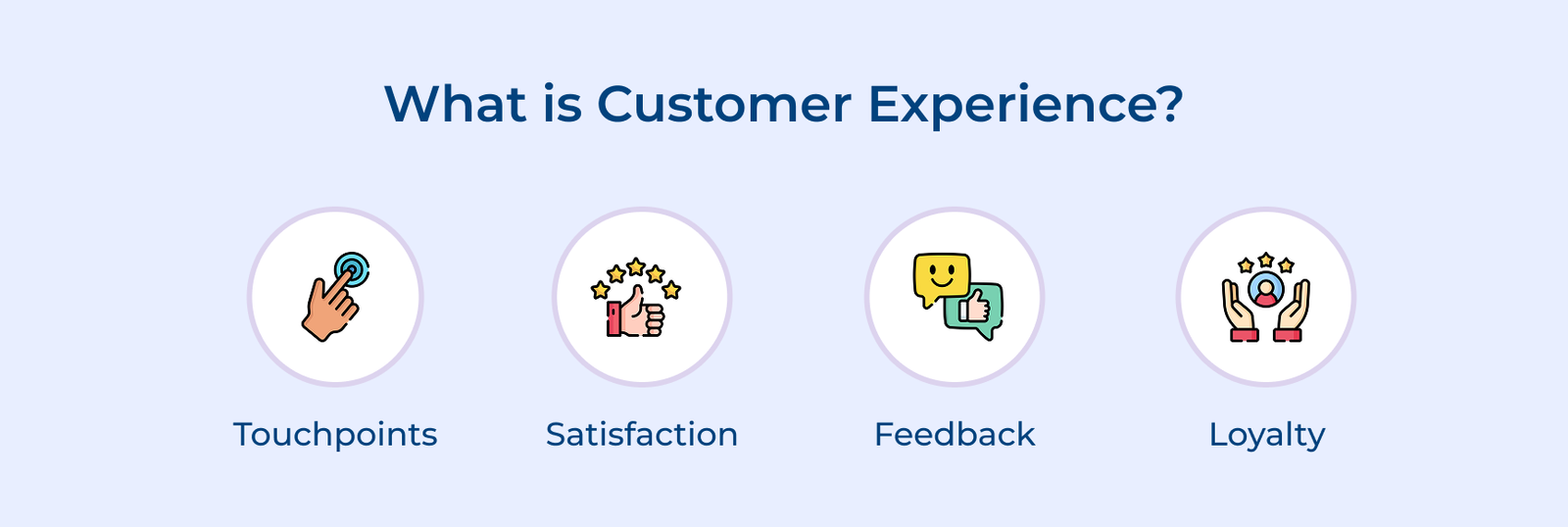
Key elements:
Let’s go through the essential steps to accurately measure and enhance your customer experience, enabling you to turn insights into lasting customer relationships.

Choosing appropriate metrics for CX measurement will be our ultimate tool for measuring the CX experience. When measuring experience, it is always recommended to perform journey-based rather than touchpoint-based.
Choose appropriate customer experience metrics as they allow businesses to accurately assess and analyze the overall satisfaction of customers. You can spot customer pain points by choosing the right metrics and using them to uncover areas for improvement.
Pro tips:
KPIs help you measure how well your support efforts actually work. Focus on those that reflect customer experience directly, such as:
KPIs are crucial in measuring customer experience as they provide valuable insights into the effectiveness of your strategies. Measure the success of customer experience initiatives and tailor their strategies accordingly by monitoring various KPIs.
Tracking KPIs shows how customer experience efforts affect revenue. Identify which touchpoints have the most significant impact on customer satisfaction and benchmark their performance against industry standards.
Actionable tips:
Real-time monitoring gives immediate visibility into customer experience shifts, allowing teams to address issues before they escalate. The systems act as early warnings, highlighting anomalies in customer behavior, satisfaction or operational performance.
Key approaches:
Let’s assume there’s a banking institution that has been implementing real-time monitoring for tracking transaction completion rates, customer service wait times and mobile app performance. When slowdowns appear, automated alerts trigger instant technical fixes, preventing frustration and keeping service quality high.
Mapping the entire customer journey helps visualize every interaction a customer has with your brand. The interactions or touchpoints occur throughout the entire journey and fall into two categories:
Digital touchpoints are the best way to analyze customer experience in an online business. It helps measure customer experience by visually showing interactions across the entire journey. The mapping helps businesses understand their customers’ needs, pain points and opportunities for improvement. It allows them to make data-driven decisions to enhance the overall customer experience.
Best practices:
Listening to customers is one of the most direct ways to measure their experience. Feedback can be gathered through surveys, interviews or online reviews. Surveys work best when tied to your KPIs, interviews uncover deeper insights and reviews reveal honest opinions from real experiences.
Key takeaways:
Benchmarking and competitive analysis provide context for your customer experience performance, highlighting areas where improvements are needed. Comparing your results to industry standards and competitors helps you spot gaps, strengths as well as the opportunities.
Key approaches:
Check out the advantages of systematically measuring customer experience and why it should be a pivotal part of your business strategy.
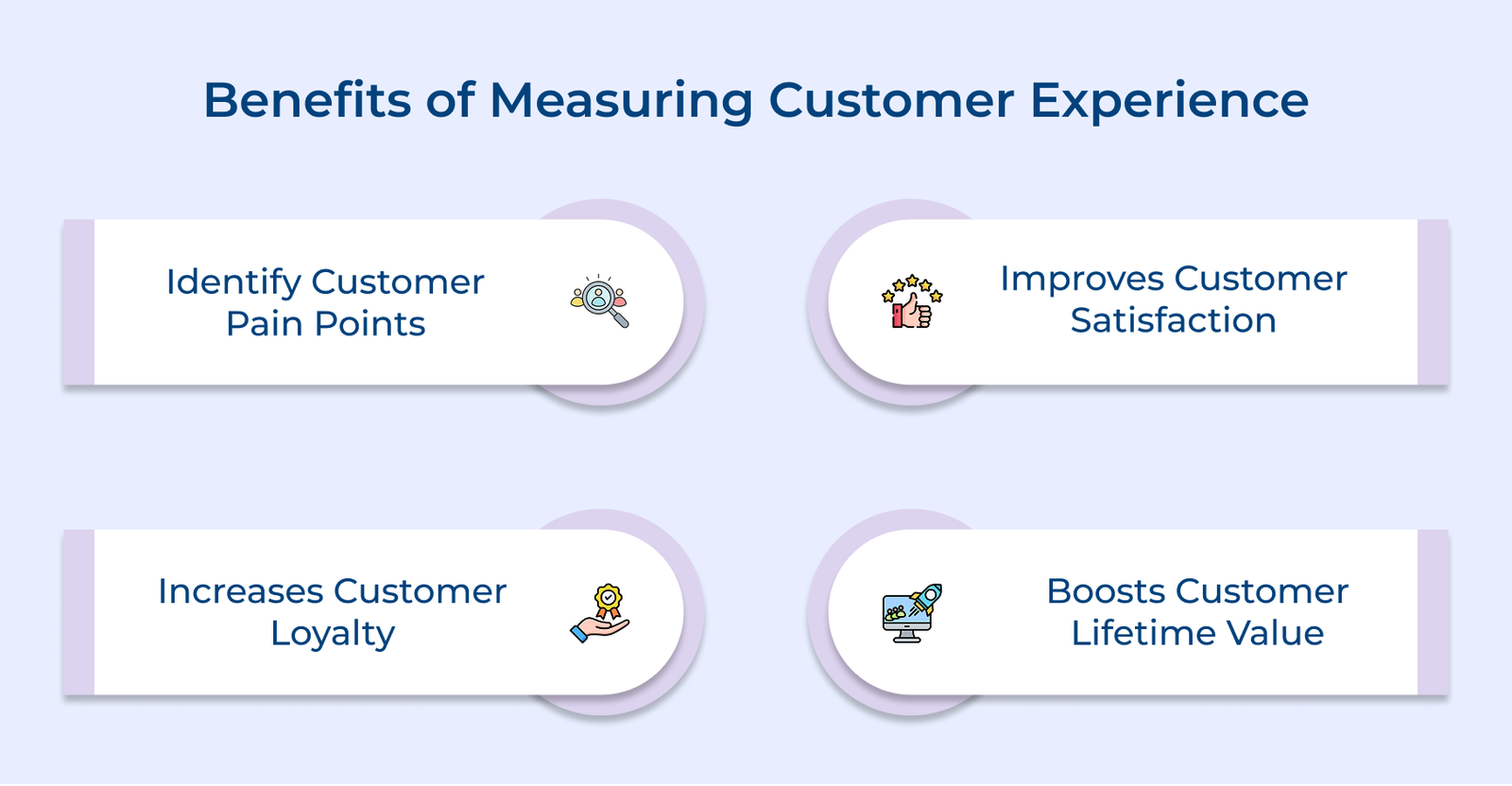
Identify customer pain points
Measuring customer experience works like a health check for your business. It highlights where customers face obstacles or frustrations, so you can address issues before they escalate.
Improves customer satisfaction
Measurement provides the roadmap for enhancing satisfaction by revealing what truly matters to customers versus organizational assumptions. Knowing which touchpoints create positive emotions helps focus resources on changes that directly improve customer happiness.
Increases customer loyalty
Regular measurement shows customers you’re listening and acting on their feedback. When they see real improvements, trust grows and loyalty follows.
Boosts customer lifetime value
A positive experience encourages customers to return, buy more often, and explore additional services. Over time, this strengthens relationships and increases overall revenue.
Let’s go through the most effective metrics that can help you comprehensively measure and improve your customer experience.
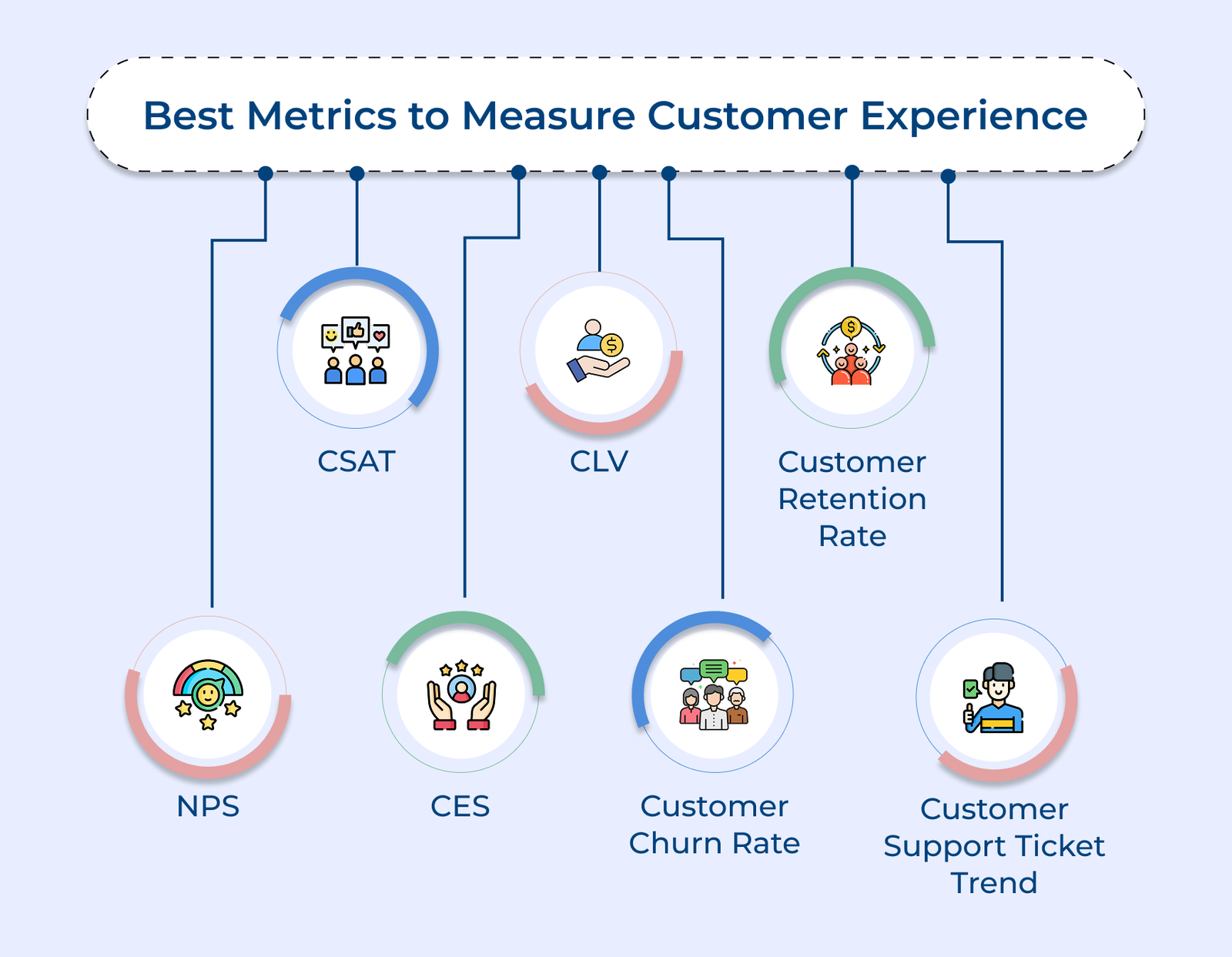
Net promoter score measures how likely customers are to recommend your business. It’s based on one simple survey question: “How likely are you to recommend our offering to a friend or colleague?”
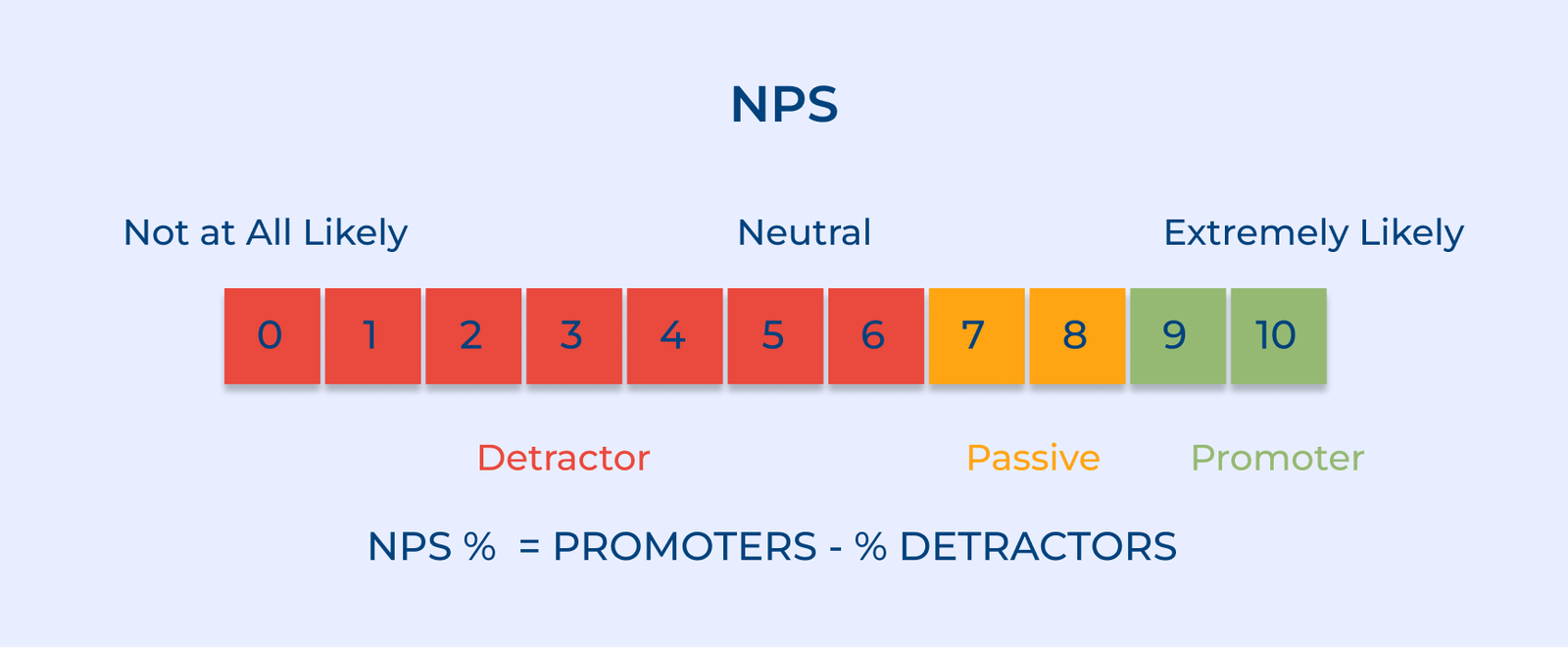
NPS Calculation
Net Promoter Score = Percentage of detractor response – Promoter response
Net promoter score will instantly show the percentage of customers who are happy with the customer experience. NPS helps track loyalty and overall satisfaction. While the score gives a snapshot, pairing it with open-ended feedback reveals why customers feel the way they do.
Pro tips:
Customer satisfaction score measures how satisfied customers are after an interaction, purchase or support experience.
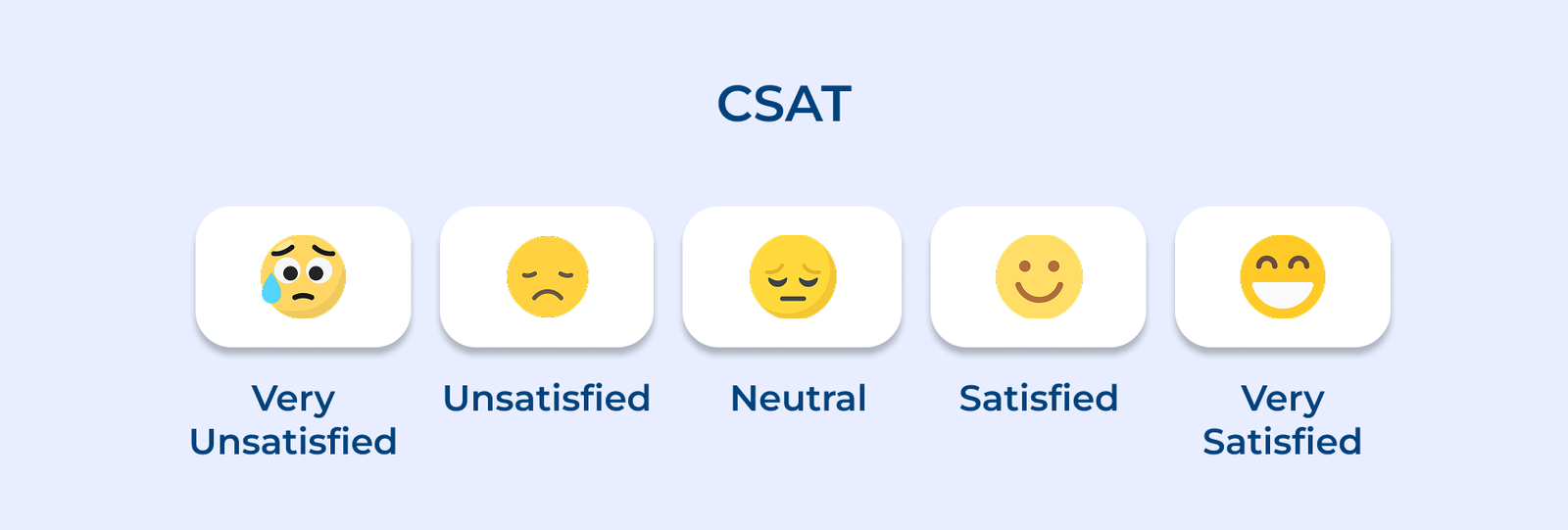
CSAT Calculation
Send a survey to the customer immediately after a purchase or interaction to measure on a corresponding scale. CSAT is widely considered to be one of the best ways to measure customer experience. It provides valuable insights into customer satisfaction levels, allowing businesses to gauge how well they are meeting their customers’ needs and expectations.
Actionable tips:
CSAT can be used in various scenarios to assess customer experience effectively. Use CSAT after interactions like support calls to gauge customer satisfaction. CSAT surveys can be sent out regularly to gauge overall satisfaction with a product or service.
Customers always prefer simple interaction. They want navigation through websites to be easy and should have easy-to-use products. The customer support team should be easily available to customers. Customer effort score allows customers to give ratings to their interaction with the company on a scale of easy, neutral or difficult.

CES Calculation
CES = sum of effort ratings/total number of survey responses
If a customer gives a difficult rating to the product, you need to innovate the product to make it more user-friendly. Measuring customer experience is crucial because it directly impacts customer loyalty, satisfaction and business success. CES measures customer effort in tasks like purchases, support calls or website use.
Best practices:
Customer lifetime value identifies how much a customer has in your business. CLV is a good customer experience metric, as you can see over time if the customer is satisfied and making repetitive purchases.
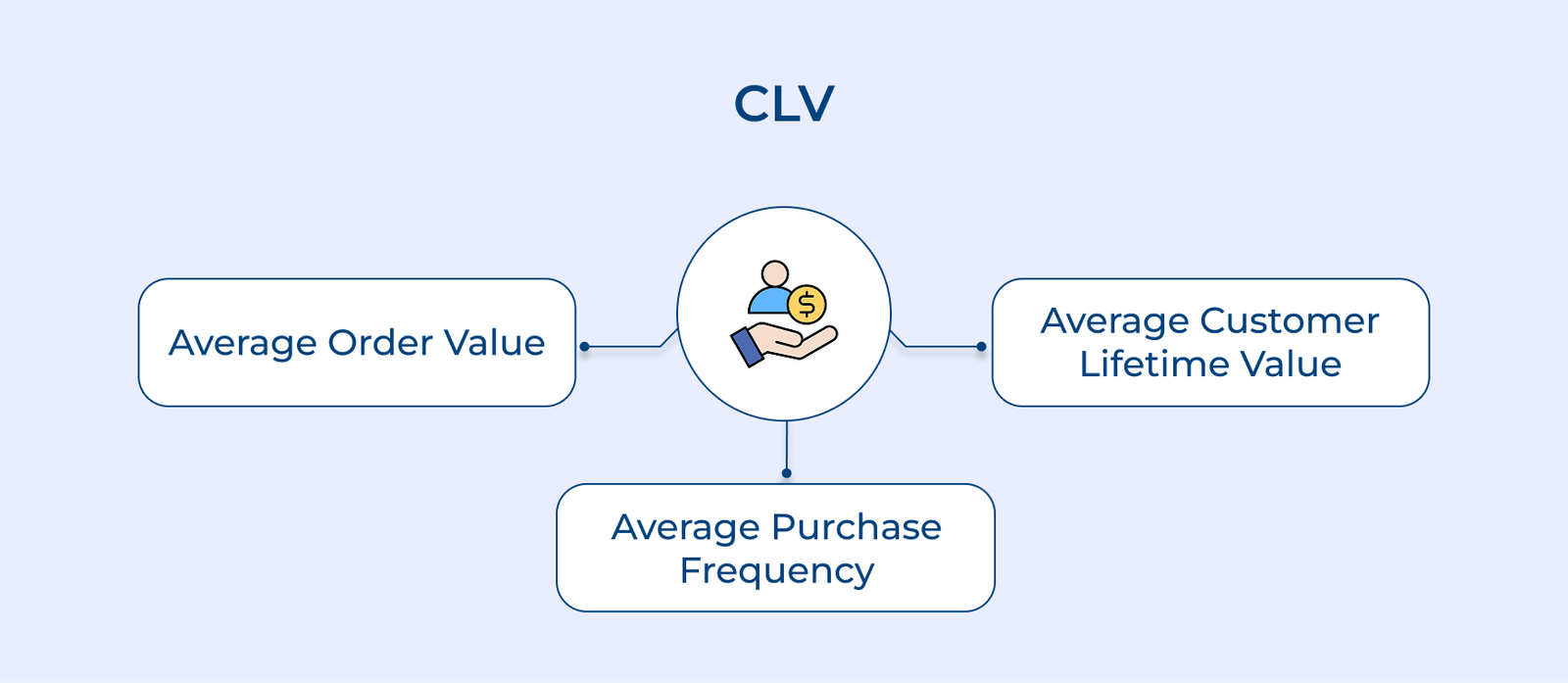
CLV Calculation
CLV = Customer value × Average customer lifespan
Higher CLV usually means stronger satisfaction and loyalty. Tracking CLV helps identify valuable segments and guide retention strategies. CLV reflects customer value by factoring in relationship length, buying habits, and loyalty. CLV assists in forecasting revenue and setting realistic sales goals.
Key takeaways:
Churn rate is the percentage of customers who have canceled or have not renewed their subscription plan over a specific period of time. Since churn is unavoidable, it is important to find out why churn is happening to reduce it as much as possible.
Churn Rate Calculation
Churn Rate = ( Customers lost /Customers at start) × 100
Pro tips:
The metric helps businesses identify patterns, allowing them to pinpoint specific reasons for churn. It enables companies to make data-driven decisions regarding customer retention strategies and allocate resources accordingly.
Customer Retention rate is mainly the opposite of churn rate. The CX metrics help to calculate how many customers are retained within a selected time range. Calculating the retention rate is a bit more complex as it requires the number of customers retained, lost and gained within the time range.

Retention Rate Calculation
Customer retention rate measures how well a business satisfies and keeps existing customers. It is important because retaining customers is more cost-effective than acquiring new ones. A high customer retention rate can lead to word-of-mouth referrals and positive reviews, which can attract new customers.
Actionable tips:
Customer support tickets act as a customer experience track, helping to point out the trends impacting customer experience. Find out if there are any recurring issues causing pain to customers. Create more explainer videos, product tweaks and reduce support tickets.
Best practices:
The customer support ticket is an essential tool for measuring the customer experience because it directly reflects customers’ interactions and concerns. Companies can identify patterns, common issues and areas for improvement by analyzing the tickets.
Measuring customer experience turns vague notions of satisfaction into actionable insights that guide real improvements. Like a navigator with multiple tools, successful businesses use various methods to fully understand their customer relationships.
The systematic approach unlocks hidden opportunities for growth while preventing costly customer defections through early intervention. Embedding measurement in company culture drives lasting value and long-term competitive advantage.
Measuring customer experience helps businesses understand satisfaction levels, identify areas for improvement and make data-driven decisions. It supports better service, boosts retention and drives long-term growth.
Data analytics plays a significant role in measuring customer experience. Analyzing customer interactions, website analytics and sales data provides businesses with actionable insights. The insights can help in identifying areas of improvement. Such insights also aid in personalizing customer experiences and predicting future customer behavior.
Businesses can gather valuable feedback from customers by asking targeted questions. The data helps identify strengths, weaknesses and areas for improvement to boost customer satisfaction. Customer satisfaction surveys provide a direct way to measure and track customer experience. Hence, helping businesses make informed decisions to meet customer expectations.
Customer feedback plays a crucial role in measuring customer experience. It reveals customer satisfaction, highlights improvement areas and clarifies customer preferences. Actively analyzing customer feedback helps businesses improve experiences, refine products and strengthen customer relationships.
Net Promoter Score (NPS) is a valuable metric that measures customer experience. It is calculated by asking customers how likely they are to recommend a company to others. NPS shows customer satisfaction and highlights areas for improvement. Tracking NPS over time helps companies assess CX strategy effectiveness and act accordingly.
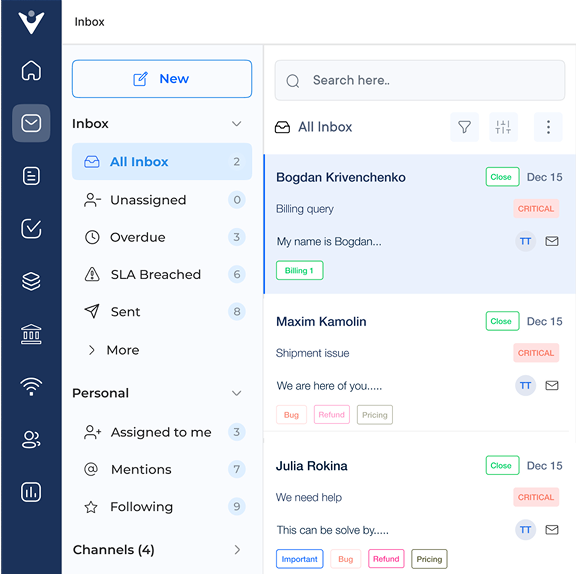
Market better, sell faster and support smarter with Veemo’s Conversation Customer Engagement suite of products.
Unify all your customer data in one platform to deliver contextual responses. Get a 360 degree view of the customer lifecycle without switching tools.
Connect with the tools you love to reduce manual activities and sync your business workflows for a seamless experience.
 https://veemo.io/wp-content/uploads/2024/12/customer-service-response-time.png
1256
2400
Webvision Solution
https://veemo.io/wp-content/uploads/2024/11/veemo.svg
Webvision Solution2025-10-17 10:51:142025-10-17 10:51:149 Effective Tips to Reduce Customer Service Response Time
https://veemo.io/wp-content/uploads/2024/12/customer-service-response-time.png
1256
2400
Webvision Solution
https://veemo.io/wp-content/uploads/2024/11/veemo.svg
Webvision Solution2025-10-17 10:51:142025-10-17 10:51:149 Effective Tips to Reduce Customer Service Response Time https://veemo.io/wp-content/uploads/2024/10/How-to-Create-Knowledge-Base.png
1257
2400
Vikas Sachan
https://veemo.io/wp-content/uploads/2024/11/veemo.svg
Vikas Sachan2024-10-21 12:24:342025-11-03 07:13:21How to Create a Knowledge Base in 9 Easy Steps: The Ultimate Guide
https://veemo.io/wp-content/uploads/2024/10/How-to-Create-Knowledge-Base.png
1257
2400
Vikas Sachan
https://veemo.io/wp-content/uploads/2024/11/veemo.svg
Vikas Sachan2024-10-21 12:24:342025-11-03 07:13:21How to Create a Knowledge Base in 9 Easy Steps: The Ultimate Guide https://veemo.io/wp-content/uploads/2024/02/Live-Chat-for-Sales.png
628
1200
teamwebvisionsolution@gmail.com
https://veemo.io/wp-content/uploads/2024/11/veemo.svg
teamwebvisionsolution@gmail.com2024-10-21 11:31:222025-08-06 10:22:06How to Use Live Chat for Sales? 7 Proven Ways to Grow Revenue
https://veemo.io/wp-content/uploads/2024/02/Live-Chat-for-Sales.png
628
1200
teamwebvisionsolution@gmail.com
https://veemo.io/wp-content/uploads/2024/11/veemo.svg
teamwebvisionsolution@gmail.com2024-10-21 11:31:222025-08-06 10:22:06How to Use Live Chat for Sales? 7 Proven Ways to Grow RevenueGrow Customer Relationships and stronger team collaboration with our range of products across the Conversational Engagement Suite.

 7 Types of Chatbots & How Businesses Can Choose the Right One
Scroll to top
7 Types of Chatbots & How Businesses Can Choose the Right One
Scroll to top